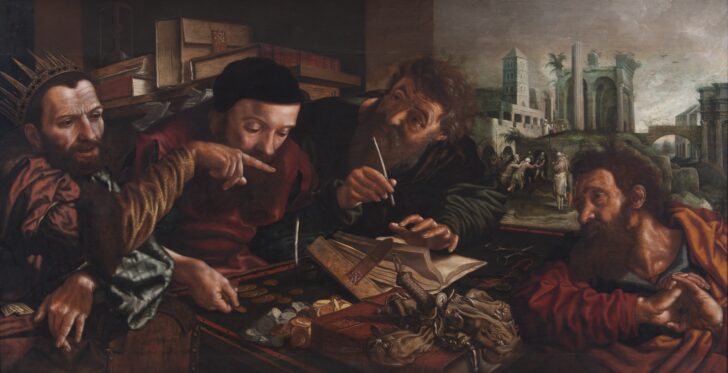The Parable of the Unmerciful Servant
Jan van Hemessen

Description
March 28, 2009
In this painting Jan Sanders van Hemessen, one of the most successful artists of his day, dramatically portrays a biblical parable about mercy and hypocrisy. The story, told by Christ in the Gospel of Matthew (18:21–35), begins with a servant who owes his king a tremendous sum of money. The king shows mercy and forgives his servant’s debt; but when the same servant later refuses to forgive a trifling debt owed him by another man, the king reverses his earlier judgment and orders the unmerciful servant cast into prison. The lesson of this tale is that God will be equally merciless to those who do not show forgiveness to others.
Hemessen’s figures fill the foreground of the painting, and their expressive faces and animated gestures create an arresting effect. On the left the king raises an accusing finger toward the servant, who sits anxiously on the right with his hands intertwined. Between them sit two men, one carefully counting coins and the other looking up at the king before making a note in his ledger. As the servant’s initial fate is decided, a window gives onto a view of the concluding scene of the story, in which he gets his just reward.
There is some evidence that this painting was made for the office of a municipal tax collector in northern Holland—an appropriate location to ponder the lessons of the parable.
Subject Matter:
Jan van Hemessen has been credited with originating this type of moralizing genre painting. Here he paints a version of one of Christ's parables from the New Testament (Matthew 18:23-35). A king was settling his accounts and a servant was unable to pay his large debt of money. After the servant pleaded for mercy, the king took pity and released him from his debt. Later, this man saw a fellow servant who owed him money and demanded payment. The man could not repay him and the servant sent him to prison. When the king heard of this, he summoned the servant and punished him since he had not shown the same mercy that was given to him by the king.
The scene of a tax collector's office was a common subject in Flemish art in the 16th century, but Van Hemesson has added the narrative elements of the parable to relate the importance of forgiveness. He has chosen to show the moment in the story when the king denounces the servant, " You wicked servant! I forgave you all that debt because you besought me: and should not you have had mercy on your fellow servant, as I had mercy on you?" (Matthew 18: 32-33)
Physical Description:
This painting depicts the interior of a room where four men are grouped around a table. They are painted as half-length figures, and their forms fill the foreground. They are painted in warm tones of brown, red and green and dressed in 16th century Netherlandish clothing. There is a king, wearing a pointed crown, who, with his right arm awkwardly crossed over his left, points to another man across the table. He has a furrowed brow and his mouth is partially open as if he is speaking. Next to him is a man looking downward, intently counting coins piled on the table. The third man pauses while writing in a book, his hand with the pen is stopped in mid-air, and looks back at the king. The fourth man, on the other side of the table, has his hands clasped in a pleading gesture and his eyes meet the gaze of the king. Items in the room and on the table such as books, scissors, a money bag, and an hourglass, are painted in great detail. In the upper right, a small outdoor scene, painted in tones of light green, shows an imaginary cityscape with a man being dragged into an underground chamber by some soldiers.
Usage Rights:
If you are interested in using an image for a publication, please visit https://umma.umich.edu/request-image/ for more information and to fill out the online Image Rights and Reproductions Request Form.